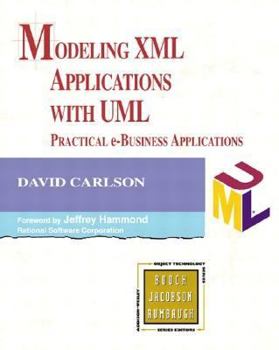Modeling XML Applications with UML: Practical e-Business Applications
(Part of the Addison-Wesley Object Technology Series Series)
Select Format
Select Condition 
Book Overview
Customer Reviews
Rated 4 starsAn excellent book covering an important niche
Like many web-related technologies XML and its many derivatives have evolved much more quickly than the support from traditional modelling and development tools. As a result many developers creating XML-based applications are doing so with the crudest of tools, and find it very difficult to either exchange ideas with more traditional developers, or to benefit from the strengths of more powerful tools and modelling approaches...
0Report
Rated 4 starsWell written and easy to read
David Carlson has produced a book that discusses how to integrate two important technologies: UML and XML. More than that, the book serves as a primer to both. Even if you already know UML or XML, you'll probably learn something new about each. References are supplied for those who want to learn more. For me, I also found that the book planted seeds for new ideas.The material is presented in a practical way, around a simple...
0Report
Rated 5 starsTitle does not do this book justice
David Carlson's book on "Modeling XML Applications with UML" is an excellent contribution to the business of building distributed e-Business applications. My only complaint with the book is the title which emphasizes the subject of UML over the subtitle of "Practical e-Business Applications." Mr. Carlson painstakingly builds up the requisite knowledge one must possess around XML, DTD, XML Schema, other XML schemas, XSL, XSLT,...
0Report
Rated 5 starsExcellent example of XML business application
I read this book to get a better understanding of UML--and I am very pleased at how useful it was. What was a nice surprise is to have found an excellent book on XML business applications. I am one of the orginal founders of XML, so really was not expecting this.A must read for anyone interested in modeling, UML or how XML should be used in eBusiness.
0Report
Rated 5 starsFinest XML book
I just picked up "XML/UML" and am ecstatic!! I have to thank Dave for putting all of this practical info together. It is what I was so desperatly looking for. From all the dozens of books I've purused at the bookstores I can say this is the ONLY high level book about XML apps on the market. This book takes one beyond modelling and into the belly of the beast of real world application production. I've looked at (and unfortunetly...
0Report















